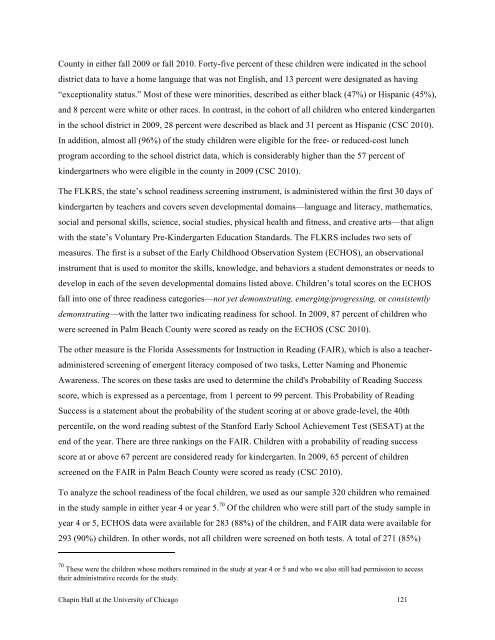2011 The Palm Beach County Family Study (Full Report)
2011 The Palm Beach County Family Study (Full Report)
2011 The Palm Beach County Family Study (Full Report)
- No tags were found...
Create successful ePaper yourself
Turn your PDF publications into a flip-book with our unique Google optimized e-Paper software.
<strong>County</strong> in either fall 2009 or fall 2010. Forty-five percent of these children were indicated in the schooldistrict data to have a home language that was not English, and 13 percent were designated as having“exceptionality status.” Most of these were minorities, described as either black (47%) or Hispanic (45%),and 8 percent were white or other races. In contrast, in the cohort of all children who entered kindergartenin the school district in 2009, 28 percent were described as black and 31 percent as Hispanic (CSC 2010).In addition, almost all (96%) of the study children were eligible for the free- or reduced-cost lunchprogram according to the school district data, which is considerably higher than the 57 percent ofkindergartners who were eligible in the county in 2009 (CSC 2010).<strong>The</strong> FLKRS, the state’s school readiness screening instrument, is administered within the first 30 days ofkindergarten by teachers and covers seven developmental domains—language and literacy, mathematics,social and personal skills, science, social studies, physical health and fitness, and creative arts—that alignwith the state’s Voluntary Pre-Kindergarten Education Standards. <strong>The</strong> FLKRS includes two sets ofmeasures. <strong>The</strong> first is a subset of the Early Childhood Observation System (ECHOS), an observationalinstrument that is used to monitor the skills, knowledge, and behaviors a student demonstrates or needs todevelop in each of the seven developmental domains listed above. Children’s total scores on the ECHOSfall into one of three readiness categories—not yet demonstrating, emerging/progressing, or consistentlydemonstrating—with the latter two indicating readiness for school. In 2009, 87 percent of children whowere screened in <strong>Palm</strong> <strong>Beach</strong> <strong>County</strong> were scored as ready on the ECHOS (CSC 2010).<strong>The</strong> other measure is the Florida Assessments for Instruction in Reading (FAIR), which is also a teacheradministeredscreening of emergent literacy composed of two tasks, Letter Naming and PhonemicAwareness. <strong>The</strong> scores on these tasks are used to determine the child's Probability of Reading Successscore, which is expressed as a percentage, from 1 percent to 99 percent. This Probability of ReadingSuccess is a statement about the probability of the student scoring at or above grade-level, the 40thpercentile, on the word reading subtest of the Stanford Early School Achievement Test (SESAT) at theend of the year. <strong>The</strong>re are three rankings on the FAIR. Children with a probability of reading successscore at or above 67 percent are considered ready for kindergarten. In 2009, 65 percent of childrenscreened on the FAIR in <strong>Palm</strong> <strong>Beach</strong> <strong>County</strong> were scored as ready (CSC 2010).To analyze the school readiness of the focal children, we used as our sample 320 children who remainedin the study sample in either year 4 or year 5. 70 Of the children who were still part of the study sample inyear 4 or 5, ECHOS data were available for 283 (88%) of the children, and FAIR data were available for293 (90%) children. In other words, not all children were screened on both tests. A total of 271 (85%)70 <strong>The</strong>se were the children whose mothers remained in the study at year 4 or 5 and who we also still had permission to accesstheir administrative records for the study.Chapin Hall at the University of Chicago 121
















